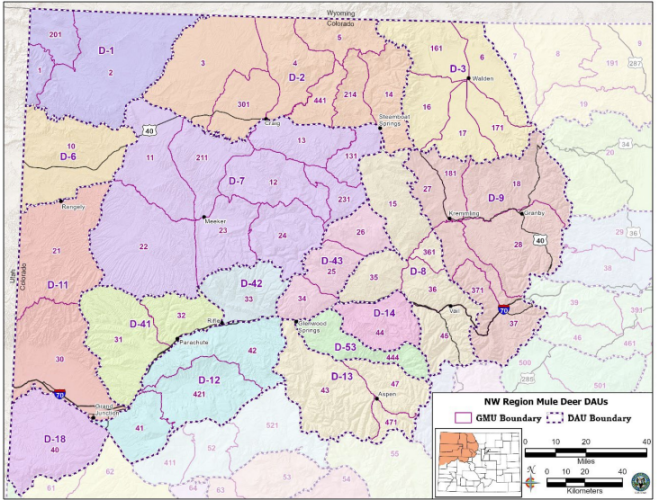
Grand Junction, Colo. – Colorado Parks and Wildlife seeks input on draft Herd Management Plans (HMPs) for 16 deer herds in northwest Colorado. The draft plans are now open to public review and comment through Dec. 20.
In 2023, Colorado Parks and Wildlife staff will present a Regional HMPs document for approval to the Parks and Wildlife Commission to address several HMPs that need to be updated. This is a new approach to create a Regional roll-up of all HMPs for a single big game species in the region, updating or establishing new population and sex ratio objectives. The Regional plans also describe the individual HMPs for each herd, significant management issues for herds within each Region, and public input used to develop proposed objectives. Previously, Colorado Parks and Wildlife staff have presented one Herd Management Plan at a time for approval to the Parks and Wildlife Commission.
CPW is proposing new management objectives for nine of the 16 deer herds in the Region. Recommended updates are being proposed for the D-1 Little Snake, D-2 Bear’s Ears, D3 - North Park, D-6 Rangely, D12 - Grand Mesa North, D13 - Maroon Bells, D18 - Glade Park, D41 - Logan Mountain, D43 - Sweetwater Creek deer HMPs.
“When you look at the draft plan, you will see proposed population objectives are lower than historic objectives,” said NW Senior Wildlife Biologist Brad Banulis. "These recommendations are based on several factors, including habitat conditions with persistent drought conditions leading to increased competition for forage, disturbance on important seasonal habitats, and public input. In some of these areas, we're seeing an increased presence of chronic wasting disease (CWD). To help manage that, some sex ratio objectives have changed to provide more hunting opportunities."
CPW is proposing extensions of recently approved management objectives for the D-7 White River, D-8 State Bridge, D-9 Middle Park, D-11 Bookcliffs, D-14 Brush Creek, D-42 Rifle Creek, and D-53 Basalt herds that have all been approved by the Parks and Wildlife Commission over the last three years. Extensions are recommended when CPW staff believe a continuation of the previous objectives, course of management actions and strategies are sufficient for a given herd.
“Public input plays an important role in our decision making process,” said NW Region Manager Travis Black. “Colorado Parks and Wildlife relies on the feedback we hear from the public to help give guidance on policy and plans to conserve and manage our resources.”
The draft deer plans are open to public comment through Dec. 20. Please submit public comments to Brad Banulis at [email protected].
Comments also will be accepted by mail addressed to:
Colorado Parks and Wildlife
Attn: Brad Banulis
711 Independent Avenue
Grand Junction, CO 81505
The purpose of a HMP plan is to integrate the plans and intentions of Colorado Parks and Wildlife with the concerns and ideas of land management agencies and interested public to determine how a big game herd in a Data Analysis Unit (DAU) should be managed.
In preparing a HMP plan, agency personnel attempt to balance the biological capabilities of the herd and its habitat with the public's demand for wildlife recreational opportunities.
HMPs are used to establish management objectives for each herd in terms of a desired population size range and sex ratio. Each plan also describes additional strategies and techniques that will be used to achieve the desired herd objectives. The goal for the 10-year term of these plans is to manage to the most appropriate population level within the objective range based on climatic patterns, habitat conditions, forage availability and public desires. The management alternatives selected in these plans will help drive annual license setting decisions.
To view all Herd Management Plans for CPW’s Northwest Region, visit our website.




